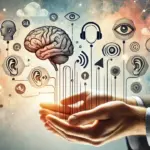Introduction
In today’s fast-paced world, understanding and managing our emotions is more crucial than ever. Emotional Intelligence, often referred to as EQ, plays a pivotal role in our daily interactions, decisions, and overall well-being. But what if I told you there’s a powerful tool that can help boost your EQ? Enter Neuro-Linguistic Programming, or NLP. At its core, NLP is about communication, personal development, and psychotherapy. It offers techniques and insights that can significantly enhance one’s emotional intelligence. Throughout this blog, I’ll delve into the intricate connection between NLP and EQ and provide practical guidance on how you can harness the power of Neuro-Linguistic Programming to elevate your Emotional Intelligence. Whether you’re a student, a professional, a housewife, or someone simply curious about personal growth, this journey holds valuable insights for everyone. Let’s embark on this transformative path together.
Understanding Emotional Intelligence
Emotional Intelligence, commonly abbreviated as EQ, is the ability to recognize, understand, and manage our own emotions while also being attuned to the emotions of others. It’s a skill that goes beyond the confines of traditional intelligence metrics and plays a vital role in determining our success in relationships, work, and even our physical well-being.
At the heart of EQ lies self-awareness. It’s the foundation upon which I can understand my emotional triggers, strengths, and areas that need improvement. This self-awareness, in turn, aids in self-regulation, allowing me to manage impulsive feelings and behaviors, navigate complex situations, and make thoughtful decisions.
But EQ isn’t just about introspection. It’s also about empathy – the ability to perceive and relate to the emotions of those around me. Empathy enables me to build deeper connections, foster trust, and navigate social intricacies with grace. It’s what allows a teacher to understand the unspoken struggles of a student, a therapist to resonate with a client’s feelings, or a businessperson to negotiate effectively.
Furthermore, the significance of **Emotional Intelligence improvement** cannot be overstated. A heightened EQ paves the way for better communication, improved relationships, and a more fulfilling life. It’s the bridge that connects our internal emotional world with the external environment.
Incorporating NLP techniques can offer a fresh perspective and practical tools to enhance this bridge. As I delve deeper into the world of **Neuro-Linguistic Programming and EQ**, it becomes evident that the two are intrinsically linked, each amplifying the benefits of the other. By understanding the essence of Emotional Intelligence, we set the stage for a transformative journey with NLP.
Basics of Neuro-Linguistic Programming (NLP)
Neuro-Linguistic Programming, often abbreviated as NLP, might sound like a complex term, but its essence is rooted in the simple yet profound interplay between our brain (neuro), language (linguistic), and behavioral patterns (programming). At its core, NLP is a holistic approach to understanding human experience, communication, and behavior.
Let’s break it down:
- Neuro refers to our neurological processes, the way our brain functions, and how we process information from our five senses.
- Linguistic emphasizes the role of language in shaping our thoughts, emotions, and behaviors. It’s about how we communicate with ourselves (internal dialogue) and with others (verbal and non-verbal communication).
- Programming is about the patterns or ‘programs’ we run in our minds, influencing how we perceive the world, make decisions, and react to situations.
For someone new to NLP, it’s essential to understand that it’s not just a set of tools or techniques. It’s a dynamic approach to personal development and therapy. NLP offers insights into how our mind works, how we form beliefs, and how these beliefs influence our actions.
One of the most compelling aspects of NLP is its practicality. It provides actionable techniques that can lead to immediate changes in perception and behavior. For instance, by understanding and altering our internal dialogues, I can shift from a negative mindset to a more positive and empowering one.
The Emotional Intelligence and NLP connection is particularly intriguing. While EQ focuses on understanding and managing emotions, NLP offers the tools to make these changes tangible. As we journey further, I’ll demonstrate how NLP can be a catalyst for Enhancing Emotional Intelligence, making it accessible and relatable to everyone, from students to professionals and everyone in between.
NLP Techniques for Boosting EQ
Neuro-Linguistic Programming offers a treasure trove of techniques designed to enhance our understanding of emotions and improve our Emotional Intelligence. As I’ve delved deeper into NLP, I’ve discovered that these techniques are not just theoretical concepts but practical tools that can bring about profound changes in our emotional landscape. Here are some pivotal NLP techniques that can boost EQ:
1. Anchoring
- Just as a ship’s anchor holds it steady amidst the waves, NLP anchoring allows us to capture and recall positive emotional states at will. By associating a specific gesture, word, or touch with a desired emotion, I can ‘anchor’ that feeling and evoke it whenever needed. This technique is particularly useful in situations where I need to remain calm, confident, or motivated.
2. Reframing
- Our perception of events often dictates our emotional response. Reframing involves changing the way I perceive an event, thereby altering my emotional reaction to it. For instance, viewing challenges as opportunities rather than threats can shift my mindset from anxiety to excitement.
3. Swish Pattern
- This technique is about replacing an undesirable emotion or behavior with a desired one. Imagine sliding away a negative image and replacing it with a positive one, like swiping on a smartphone. Over time, this ‘swish’ can reprogram my emotional responses.
4. Meta Model
- The Meta Model is a set of questions designed to clarify and expand on vague or limiting statements. By challenging and exploring these statements, I can gain a deeper understanding of my beliefs and emotions, leading to more clarity and better communication.
5. Visual/Kinesthetic Dissociation (VKD)
- Often used for overcoming traumatic memories, VKD involves viewing a distressing event as an observer rather than a participant. By distancing myself from the emotion, I can process it more objectively, reducing its negative impact.
6. Belief Change
- Our beliefs shape our emotions and behaviors. NLP offers techniques to challenge and modify limiting beliefs, paving the way for emotional growth and empowerment.
7. Rapport Building
- Building rapport is about establishing trust and understanding with others. NLP teaches techniques like mirroring and matching body language, tone, and pace to create a sense of connection, enhancing interpersonal communication and empathy.
8. Submodalities
- These are the finer details of our internal representations – the brightness, size, or distance of an image in our mind, or the volume and tone of an internal dialogue. By adjusting these submodalities, I can change the intensity of my emotions. For instance, dimming a distressing memory can reduce its emotional impact.
9. Parts Integration
- We often experience internal conflicts, like a part of us wanting to exercise and another wanting to relax. NLP’s parts integration technique helps in resolving these conflicts, leading to a more harmonious emotional state.
10. Future Pacing
- This technique involves visualizing a desired future outcome, embedding it in our subconscious. By doing so, I can align my emotions and actions towards achieving that goal.
Incorporating these NLP techniques for emotions into daily practice can lead to significant Emotional Intelligence improvement. They offer a roadmap to NLP emotional training, equipping individuals with tools to navigate the complex world of emotions. Whether it’s enhancing self-awareness, improving empathy, or managing stress, NLP holds the key to Strengthening EQ with Neuro-Linguistic Programming. As we continue this journey, I invite you to explore these techniques, experiment with them, and experience the transformative power of NLP in boosting Emotional Intelligence.
Benefits of Combining EQ and NLP
The fusion of Emotional Intelligence (EQ) and Neuro-Linguistic Programming (NLP) offers a potent blend of self-awareness and actionable techniques, creating a pathway to personal and professional growth. As I’ve integrated both into my life, I’ve witnessed a myriad of benefits that have not only enriched my emotional well-being but also enhanced my interactions with the world around me. Here are some of the standout benefits of combining EQ and NLP:
1. Enhanced Self-awareness
- While EQ emphasizes the importance of understanding our emotions, NLP provides the tools to delve deeper. Techniques like reframing and the Meta Model allow me to dissect my feelings, beliefs, and behaviors, leading to a heightened sense of self-awareness.
2. Improved Communication
- The rapport-building techniques of NLP, combined with the empathetic understanding fostered by EQ, pave the way for effective and meaningful communication. I’ve found that I can connect more genuinely, listen actively, and express myself with clarity and compassion.
3. Emotional Resilience
- Life is replete with challenges. The anchoring and swish pattern techniques of NLP, coupled with the emotional regulation aspect of EQ, equip me with the resilience to navigate adversities with grace and poise.
4. Empowered Decision-making
- A heightened EQ ensures that I’m in tune with my emotions, while NLP techniques like future pacing enable me to visualize outcomes. This combination empowers me to make decisions that are both emotionally and logically sound.
5. Deeper Relationships
- The empathy fostered by EQ, complemented by NLP’s rapport-building techniques, allows me to forge deeper, more meaningful relationships. I’ve learned to understand and value the emotions of others, leading to trust and mutual respect.
6. Personal Growth and Transformation
- The journey of combining EQ and NLP is transformative. By continuously working on Emotional Intelligence improvement and applying NLP for better emotional understanding, I’ve experienced profound growth, both emotionally and personally.
In essence, the synergy of EQ and NLP offers a holistic approach to emotional well-being and personal development. It’s a journey of discovery, empowerment, and transformation, and I invite everyone to experience the myriad benefits that this fusion brings.
Applications in Real Life
The practicality of intertwining Emotional Intelligence (EQ) and Neuro-Linguistic Programming (NLP) extends far beyond theoretical knowledge. In my journey with EQ and NLP, I’ve discovered that their applications permeate various facets of daily life, touching individuals from all walks of life. Here’s how different individuals can harness the power of EQ and NLP in real-world scenarios:
1. Students
- In the realm of academia, EQ and NLP can be instrumental. Students can use NLP techniques to manage exam stress, enhance focus, and improve interpersonal relationships with peers. A heightened EQ aids in understanding and managing emotions like anxiety and frustration, paving the way for a more balanced academic life.
2. Teachers
- Educators can employ EQ to foster a more empathetic and understanding classroom environment. NLP techniques can assist in effective communication, ensuring that each student feels heard and valued.
3. Professionals
- Doctors, therapists, coaches, and counselors can integrate EQ and NLP to build rapport with patients and clients, understanding their emotional needs and offering tailored solutions. Businessmen can leverage these skills for effective negotiations, team management, and leadership.
4. Housewives
- Managing a household is no small feat. Housewives can use EQ to navigate family dynamics, understanding the emotions and needs of family members. NLP techniques can aid in conflict resolution, stress management, and fostering a harmonious home environment.
5. Therapists and Counselors
- In therapeutic settings, the combination of EQ and NLP can be transformative. Therapists can employ NLP techniques to delve deeper into a client’s psyche, offering solutions tailored to their emotional needs.
6. Businessmen
- In the corporate world, EQ and NLP can be game-changers. From team management to negotiations, understanding emotions and employing NLP techniques can lead to more effective communication, leadership, and decision-making.
In essence, the applications of EQ and NLP are vast and varied. Regardless of one’s profession or life situation, integrating Emotional Intelligence and Neuro-Linguistic Programming can lead to enhanced emotional well-being, improved relationships, and a more fulfilling life. As I continue to apply these principles in my life, I encourage everyone to explore and experience the tangible benefits they offer in real-life scenarios.
Conclusion
The journey of intertwining Emotional Intelligence (EQ) with Neuro-Linguistic Programming (NLP) is both enlightening and transformative. As I’ve delved into this fusion, I’ve realized that it’s not just about understanding emotions but actively shaping our emotional landscape. EQ provides the foundation, while NLP offers the tools to build upon it. Together, they pave the way for enhanced self-awareness, deeper connections, and a more fulfilling life. I invite you to embrace this journey, harnessing the power of EQ and NLP to navigate the complexities of emotions and relationships, and to truly thrive in every facet of life.










